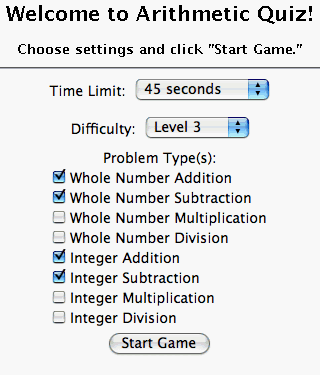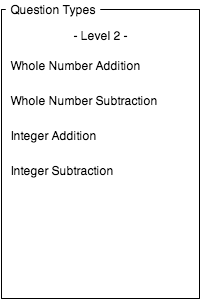What is Arithmetic Quiz?
This activity allows a student to practice his or her arithmetic with whole numbers and integers. The student can choose to answer problems involving whole number and integer addition, subtraction, multiplication, and division. The student can also choose the difficulty level and the amount of time available to solve each problem.
When adding or subtracting integers, consider the number line. The minus sign is always a negation of the positive direction, whether the minus sign represents the operation of subtraction or the sign on the integer.
For example take the addition problem 5 + -7 = -2.

Or take the subtraction problem 5 - -2 = 7.

How Do I Use This Activity?
This activity allows the user to practice addition, subtraction, multiplication, and division.
In this applet, questions are categorized by a combination of level (which determines the difficulty) and by types of problems listed. For more information on how questions are generated and what each level and problem type means, see Question Types for Arithmetic Quiz and Arithmetic Four.
Controls and Output
-
Before you start the game you can set several options. You can choose how much time each
player will have to answer the questions, you can choose the problem difficulty (Level 1,
Level 2, Level 3), and you can select the types of arithmetic problems you want to see.
Once you have all of the settings as you want them, click the
Start Game button.

-
After clicking the
Start Game button, a new screen appears. Towards the left of the screen is a table that lists the
types of questions selected along with the difficulty level.

-
To answer the question, enter your answer into the answer textbox:

-
After you have entered your answer, you need to click on the
Answer button to find out if you are correct.

-
You have a limited amount of time to answer the question. The
Elapsed Time above the answer textbox shows how much time has elapsed. Once the elapsed time reaches
the amount you set before the game, the time is up.

-
If you want to restart the game, you can do so by clicking on the
New Game button:

- This quiz will automatically record how successful you are at answering the questions. To view the score, press the Show Score button at the bottom of the activity and a pop-up window will appear with the scoreboard. To close this pop-up window press the Close button or click back on the main window.
- To pause the scoring, press the Active button at the bottom of the screen and it will change to a Paused button. To resume scoring, press the Paused button.
- To reset the scoreboard, open the scoreboard using the Show Score button and then press the Reset button.
Description
This activity allows a student to practice his or her arithmetic with whole numbers and integers. The student can choose to answer problems involving whole number and integer addition, subtraction, multiplication, and division. They can also choose the difficulty level and the amount of time they have to solve the problem. This activity would work well in groups of 2 for about 25-30 minutes if you use the exploration questions and 15-20 minutes otherwise.
Place in Mathematics Curriculum
This activity can be used to:
- Give students practice with basic math
- Teach students the differences between whole numbers and integers
Standards Addressed
Grade 3
-
Estimation and Computation
- The student determines reasonable answers to real-life situations, paper/pencil computations, or calculator results.
- The student accurately solves problems (including real-world situations).
-
Numeration
- The student demonstrates conceptual understanding of whole numbers up to one thousand.
Grade 4
-
Estimation and Computation
- The student determines reasonable answers to real-life situations, paper/pencil computations, or calculator results.
- The student accurately solves problems (including real-world situations).
-
Numeration
- The student demonstrates conceptual understanding of whole numbers to ten thousands.
Grade 5
-
Estimation and Computation
- The student determines reasonable answers to real-life situations, paper/pencil computations, or calculator results.
- The student accurately solves problems (including real-world situations).
-
Numeration
- The student demonstrates conceptual understanding of whole numbers to millions.
Grade 6
-
Estimation and Computation
- The student accurately solves problems (including real-world situations).
-
Measurement
- The student demonstrates understanding of measurable attributes.
Grade 7
-
Estimation and Computation
- The student accurately solves problems (including real-world situations).
Grade 8
-
Estimation and Computation
- The student accurately solves problems (including real-world situations).
Grade 9
-
Estimation and Computation
- The student accurately solves problems (including real-world situations).
-
Numeration
- The student demonstrates conceptual understanding of real numbers.
Grade 10
-
Estimation and Computation
- The student accurately solves problems (including real-world situations).
-
Numeration
- The student demonstrates conceptual understanding of real numbers.
Grade 3
-
Number Sense
- 2.0 Students calculate and solve problems involving addition, subtraction, multiplication, and division
Grade 4
-
Number Sense
- 2.0 Students extend their use and understanding of whole numbers to the addition and subtraction of simple decimals
- 3.0 Students solve problems involving addition, subtraction, multiplication, and division of whole numbers and understand the relationships among the operations
Grade 5
-
Number Sense
- 1.0 Students compute with very large and very small numbers, positive integers, decimals, and fractions and understand the relationship between decimals, fractions, and percents. They understand the relative magnitudes of numbers
- 2.0 Students perform calculations and solve problems involving addition, subtraction, and simple multiplication and division of fractions and decimals
Grade 6
-
Number Sense
- 2.0 Students calculate and solve problems involving addition, subtraction, multiplication, and division
Grade 7
-
Number Sense
- 1.0 Students know the properties of, and compute with, rational numbers expressed in a variety of forms
Third Grade
-
Number and Operations in Base Ten
- Use place value understanding and properties of operations to perform multi-digit arithmetic.
-
Operations and Algebraic Thinking
- Represent and solve problems involving multiplication and division.
- Understand properties of multiplication and the relationship between multiplication and division.
- Multiply and divide within 100.
- Solve problems involving the four operations, and identify and explain patterns in arithmetic.
Fourth Grade
-
Number and Operations in Base Ten
- Use place value understanding and properties of operations to perform multi-digit arithmetic.
-
Operations and Algebraic Thinking
- Use the four operations with whole numbers to solve problems.
Fifth Grade
-
Number and Operations in Base Ten
- Perform operations with multi-digit whole numbers and with decimals to hundredths.
-
Operations and Algebraic Thinking
- Write and interpret numerical expressions.
Sixth Grade
-
The Number System
- Compute fluently with multi-digit numbers and find common factors and multiples.
Eighth Grade
-
Expressions and Equations
- Work with radicals and integer exponents.
Grades 3-5
-
Numbers and Operations
- Compute fluently and make reasonable estimates
Grades 6-8
-
Numbers and Operations
- Compute fluently and make reasonable estimates
- Understand meanings of operations and how they relate to one another
Grades 9-12
-
Numbers and Operations
- Compute fluently and make reasonable estimates
Grade 3
-
Number and Operations, Measurement, Geometry, Data Analysis and Probability, Algebra
- COMPETENCY GOAL 1: The learner will model, identify, and compute with whole numbers through 9,999.
Grade 4
-
Number and Operations, Measurement, Geometry, Data Analysis and Probability, Algebra
- COMPETENCY GOAL 1: The learner will read, write, model, and compute with non-negative rational numbers.
Grade 5
-
Number and Operations, Measurement, Geometry, Data Analysis and Probability, Algebra
- COMPETENCY GOAL 1: The learner will understand and compute with non-negative rational numbers.
Grade 6
-
Number and Operations, Measurement, Geometry, Data Analysis and Probability, Algebra
- COMPETENCY GOAL 1: The learner will understand and compute with rational numbers.
Grade 7
-
Number and Operations, Measurement, Geometry, Data Analysis and Probability, Algebra
- COMPETENCY GOAL 1: The learner will understand and compute with rational numbers.
Technical Mathematics I
-
Number and Operations
- Competency Goal 1: The learner will apply various strategies to solve problems.
Integrated Mathematics
-
Number and Operations
- Competency Goal 1: The learner will perform operations with numbers and expressions to solve problems.
Integrated Mathematics III
-
Number and Operations
- Competency Goal 1: The learner will perform operations with numbers and algebraic expressions to solve problems.
6th Grade
-
Numbers and Operations
- The student will demonstrate through the mathematical processes an understanding of the concepts of whole-number percentages, integers, and ratio and rate; the addition and subtraction of fractions; accurate, efficient, and generalizable methods of multiplying and dividing fractions and decimals; and the use of exponential notation to represent whole numbers.
5th Grade
-
Number and Operation
- The student will develop number and operation sense needed to represent numbers and number relationships verbally, symbolically, and graphically and to compute fluently and make reasonable estimates in problem solving.
3rd Grade
-
Numbers and Operations
- The student will develop number and operation sense needed to represent numbers and number relationships verbally, symbolically, and graphically and to compute fluently and make reasonable estimates in problem solving.
4th Grade
-
Number and Operation
- The student will develop number and operation sense needed to represent numbers and number relationships verbally, symbolically, and graphically and to compute fluently and make reasonable estimates in problem solving.
Grade 3
-
Number, Operation, and Quantitative Reasoning
- 3. The student adds and subtracts to solve meaningful problems involving whole numbers.
- 4. The student recognizes and solves problems in multiplication and division situations.
Grade 4
-
Number, Operation, and Quantitative Reasoning
- 3. The student adds and subtracts to solve meaningful problems involving whole numbers and decimals.
- 4. The student multiplies and divides to solve meaningful problems involving whole numbers.
Grade 5
-
Number, Operation, and Quantitative Reasoning
- 3. The student adds, subtracts, multiplies, and divides to solve meaningful problems.
Grade 6
-
Number, Operation, and Quantitative Reasoning
- 2. The student adds, subtracts, multiplies, and divides to solve problems and justify solutions.
Grade 7
-
Number, Operation, and Quantitative Reasoning
- 2. The student adds, subtracts, multiplies, or divides to solve problems and justify solutions.
Grade 8
-
Number, Operation, and Quantitative Reasoning
- 2. The student selects and uses appropriate operations to solve problems and justify solutions.
Be Prepared to
- Encourage students to try more difficult problems and decrease the allowed time
- Teach students the differences between whole numbers and integers